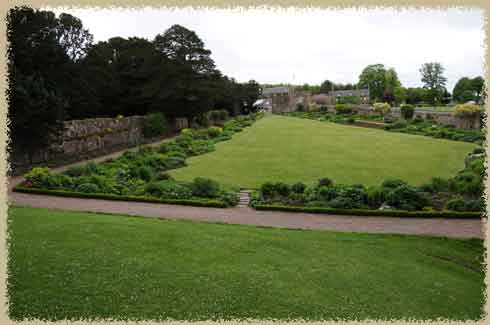Dirleton Castle

looking into the courtyard: hall to the left, Ruthven barracks on the right
The "barracks" were the primary lodging of Lady Dorothea , wife of the first Earl fo Gownie, and their 15 children. It was built of undressed stone (and thus the asusmption is it was harled). THer eis a hall on the first floor, and private rooms above. The first floor dining room has a patterned stone floor. The building would hae been a very comfortable home.
Gardens

the longest herbaceous border in the Arts and Crafts garden
The walled garden at Dirleton is award-winning, and has the longest herbeaceous border in Scotland (and possibly the world), with variety of interesting plants. The castle one would have had hundreds of acres of lands associated with it, but it is tucked into a suburb of the town now, and the surroudning gardens are mostly gone.
There is a lovely victorian garden, and an Arts and Crafts style garden on the grounds.
A dovecote (with stone cubby holes) stands at the end of the garden, on the path leading around the back of the castle.


inside the dovecot - stone cubbies / inside the kitchen fireplace
Ownership
The Congilton family owned the lands here in the 12th century. The first part of the castle here (the drum tower + small hall) was built by the De Vaux family in the 13th century. The De Vaux were French, and two brothers (or cousins?) were granted land by King David I. Hubert de Vaux was granted Gisland in Cumbria (then part of Scotland) and John was granted Dirleton.
The English controlled the castle after a long seige in 1298, but it was retaken by the Scots in 1311 and party demolished to prevent it from falling into the hands of the enemy.
The Halliburton (or Hallyburton) family owned the castle in the 15th century, and they extended it to include the enormous eastern range.


